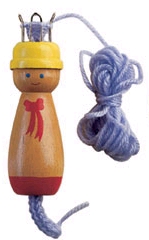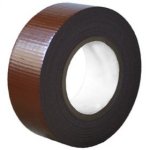In my office, I have drawer of ‘potentially useful stuff’ (or as Corey would prefer to call it, tat). The contents range from postcards to pencils, doorstops to stones, from ribbon to a plate rack. Today I was looking in the drawer for inspiration, and I found it! Today I saw French knitting looms…:
 I used to have a French knitting doll; you know the type. Mine was called a Knitting Nancy. I’ve also seen them called knitting spools, knitting reels, etc. Traditionally, they are one of the ultimate re-purposed or at least handmade craft tools. Back in the days before all cotton reels were made out of plastic, they were made out of wood; and in those days, french knitting dolls were made very simply by hammering 4 nails into the top of the wooden reel.
I used to have a French knitting doll; you know the type. Mine was called a Knitting Nancy. I’ve also seen them called knitting spools, knitting reels, etc. Traditionally, they are one of the ultimate re-purposed or at least handmade craft tools. Back in the days before all cotton reels were made out of plastic, they were made out of wood; and in those days, french knitting dolls were made very simply by hammering 4 nails into the top of the wooden reel.  I wanted to make a French knitter, but it’s impossible to get the wooden reels, any more (unless you are willing to pay ridiculously high price on an auction site). However, my drawer of potentially useful stuff yielded all kinds of interesting possibilities, and I have spent a happy Sunday morning trying them out.
I wanted to make a French knitter, but it’s impossible to get the wooden reels, any more (unless you are willing to pay ridiculously high price on an auction site). However, my drawer of potentially useful stuff yielded all kinds of interesting possibilities, and I have spent a happy Sunday morning trying them out.
 Once you start thinking laterally, there are literally tonnes of everyday things you could potentially make a French knitter from. For my first experiment, I used a doorstop, with 4 push pins pushed into the top around the hole, spaced at regular intervals.
Once you start thinking laterally, there are literally tonnes of everyday things you could potentially make a French knitter from. For my first experiment, I used a doorstop, with 4 push pins pushed into the top around the hole, spaced at regular intervals. The pins pushed in easily, but were held securely. I used an ordinary paperclip with the outer ‘leg’ bent down into a straight line to hook the yarn over the pins. The hole in the centre of the door stop narrows off to approx. 5mm diameter at the bottom, but the cord that was knitted expanded to ‘normal’ size once it came through. A normal double knitting yarn or a thick embroidery cotton would fit through without a problem.
The pins pushed in easily, but were held securely. I used an ordinary paperclip with the outer ‘leg’ bent down into a straight line to hook the yarn over the pins. The hole in the centre of the door stop narrows off to approx. 5mm diameter at the bottom, but the cord that was knitted expanded to ‘normal’ size once it came through. A normal double knitting yarn or a thick embroidery cotton would fit through without a problem.
 For my second experiment, I wanted to see how the size of the centre hole affected the thickness of the cord. I used a reel of brown insulation tape (I don’t think the colour of the tape matters, except perhaps aesthetically) with a central hole of approx. 3cm. I didn’t use the tape up first, by the way (that’s still available for a future occasion); it doesn’t really make much difference either way. My advice would be to push the pins into the inner cardboard ring, though, as when pushed into the tape they move about more. Using 4 pins, the cord was about the same thickness as the door stop cord, but a much looser knit, because of the hole’s diameter (and therefore the wider spacing of the pins). The cord was not as sturdy as the first cord, but if you especially wanted a looser, lacier effect, wider spacing of pins around a larger hole is the way forward.
For my second experiment, I wanted to see how the size of the centre hole affected the thickness of the cord. I used a reel of brown insulation tape (I don’t think the colour of the tape matters, except perhaps aesthetically) with a central hole of approx. 3cm. I didn’t use the tape up first, by the way (that’s still available for a future occasion); it doesn’t really make much difference either way. My advice would be to push the pins into the inner cardboard ring, though, as when pushed into the tape they move about more. Using 4 pins, the cord was about the same thickness as the door stop cord, but a much looser knit, because of the hole’s diameter (and therefore the wider spacing of the pins). The cord was not as sturdy as the first cord, but if you especially wanted a looser, lacier effect, wider spacing of pins around a larger hole is the way forward.
For my third experiment, I used the insulation tape knitter again, but pushed in an additional 4 pins, spaced roughly 1 cm apart around the centre hole. It was fascinating watching a real web build up between the pins, and it was obviously going to be a much closer knit than the previous experiment. The resulting cord was far more obviously tubular than the previous cords. The knitting looked like the finger of a glove (prompting me to ponder on the usefulness of ‘gloveless fingers’ as a substitute for fingerless gloves…). The knit was just a standard tension, not especially tight or loose, just ‘normal’.
Conclusion: It is the spacing (and therefore number) of pegs that affects the diameter of the cord, rather than the size of the hole itself. 4 pegs would produce roughly the same diameter cord whether knitted through a 5mm or 5cm hole, but the knit would be looser, the more widely spaced the pegs are. The larger the centre hole, the more pegs can be used, and therefore the diameter of the ‘cord’ increases accordingly – and the less cord-like it becomes.
The tubular aspect of the third experiment prompts me to imagine all kinds of possibilities. If you used a larger reel of tape as the loom, you could knit a drawstring coin pouch very easily. Or if you knitted a VERY long cord, a tubular scarf. If you found a much larger circle to use as a loom, and used a strong, non-elastic, yarn (maybe string, or garden twine?), you could knit a seamless shopping bag!
I have also previously made a successful knitter using the plastic centre of a cash till roll, with 4 paper clips clipped around the top edge. The paper clips were held in place surprisingly firmly by a single covering of sellotape. So if you don’t have push pins to hand, but you do have paperclips, you could try taping them around the inner circle of a reel of tape, instead.
Another thought: you could cut the base of a disposable drinking cup, and cut notches (like the turrets of a castle) along the rim to make a different sized knitter. Honestly, if you think about it, you can use almost anything!
Thank you for your helpful and informative article. I have just started using a loom that I was given, and it has prompted me to want to try cheap custom options in other sizes. Until I read this, I thought that I had to use nails or tape things with sharp points at the bottom ’round the outside. Since I am not handy with a hammer and don’t relish being jabbed every time I hold my loom too close, I thought that I had to wave goodbye to the idea of making my own. But you have shown me otherwise, and I will try with a wood embroidery hoop and push pins later today